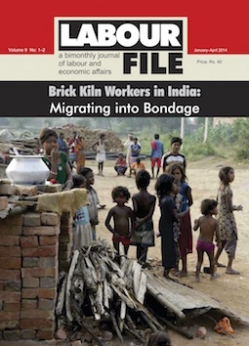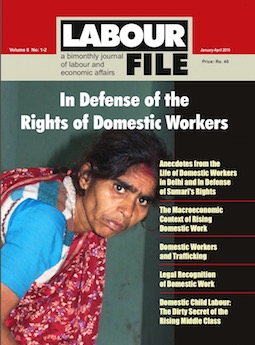Unyielding Protests by Workers across the Country
In recent times, in spite of the dangers of the COVID-19 pandemic and cutting across state boundaries, India has been witnessing massive protests by workers, including by those who belong to the unorganised sector.
The protests have become more pronounced ever since millions of workers were forced to leave their dwellings in cities and start the unprecedented migration to their villages due to the sudden announcement of a lockdown by Prime Minister Narendra Modi on 24 March 2020.
The lockdown, announced at 8 p.m. with just a 4-hour notice, wreaked havoc on millions of workers. Factories, shops and others establishments closed. The savings of workers vanished in a matter of weeks, leaving them with little to fend for themselves and their families. The only succour that came was from trade unions, civil rights groups, gurdwaras and persons with conscience, who provided them ration or ran community kitchens.
The ten Central Trade Unions(CTUs)—Hind Mazdoor Sabha (HMS), Centre for Indian Trade Unions (CITU), All India United Trade Union Centre (AIUTUC), Trade Union Coordination Centre (TUCC), Indian National Trade Union Congress (INTUC), All India Trade Union Congress (AITUC), Self Employed Women’s Association (SEWA), All India Central Council of Trade Union (AICCTU), Labour Progressive Federation (LPF) and United Trade Union Congress (UTUC)—called for the first big post-COVID-19 protest on May 22, 2020, and, thereafter, on July 3 and August 9. Each protest has seen an incremental increase in the participation of workers, with the last one being the most widespread. Lakhs of workers, across sectors, participated, including workers availing of various central schemes delivering basic services such as National Health Mission (NHM), Integrated Child Development Services (ICDS), Mid-Day Meal (MDM) Scheme and Sarva Shiksha Abhiyan (SSA).
In each protest, all the CTUs sought the implementation of the recommendations of the 45th and 46th Indian Labour Conference (ILC) on Scheme Workers. These recommendations were formulated and accepted in 2013 and 2015. The CTUs demanded the implementation of a 15-point agenda, in line with ILC recommendations, to ameliorate service workers from their hapless economic condition that continues to deteriorate.
Some important demands include: a) ensure no privatisation of basic services in health, nutrition education and PSEs; b) make centrally sponsored schemes, namely, ICDS, NHM and MDM permanent; c) regularise scheme workers as workers, with minimum monthly wages of Rs 21000 and pension of Rs 10,000 per month; d) provide ESI and PF to all scheme workers e) legalise right to universal healthcare f) make no pro-employer changes in labour laws; g) ensure no increase in working hours; h) freeze labour laws in the name of COVID-19; i) provide free ration/food for all the needy and j) deposit Rs 7500 monthly for all non-taxpaying families for six months; k) give Rs 50 lakhs insurance cover to all frontline workers, which includes death on duty and pension/jobs for dependents of workers; provide additional COVID-19 Risk Allowance of Rs 10,000 per month for all contract and scheme workers engaged in COVID-19 duty, especially the (Accredited Social Health Activist) ASHA and the anganwadi workers and workers in NHM; l) pay immediately all pending dues of wages and allowances to all scheme workers. (Please see the demands in full in the attached file.)
According to CITU’s general secretary, Tapan Sen, the chain of strikes and protests will continue without a break and relentlessly because that seems to be the only way to check the present government, whose sole aim is to “break the backbone of Indian industry and hand it over to crony capitalists of India and the West.”
“Our next national-level strike-cum-protest will be held on September 23. We have compelled the central government to retract its steps in certain areas. For example, the coal workers’ three-day strike in July forced the government to defer the coal blocs auction for two months after it found no bidders. Similar successes have been achieved by the workers in the ordinance factory, Bharat Petroleum and other sectors,” says Sen.
Sen said even the affiliate of RSS, the BMS and the unions it supports, in different sectors, are coming out in solidarity, even though, at the national level, BMS maintains a distance because of political compulsions.
According to Ashok Ghosh, general secretary of UTUC, despite being the first line of defence against the dreaded Corona pandemic, ASHA, anganwadi, NHM and SSA workers are feeling cheated because they continue to get a raw deal from the central and the state governments.
“Not only are they treated as non-workers but they are also paid a paltry monthly honorarium of Rs 4000 in most states, for doing working in difficult circumstances on an average of 12 hours a day,” said Ghosh.
The Office of the Central Labour Commissioner, Ministry of Labour and Employment, through a notification on 8 May 2020, fixed the minimum wage for an unskilled worker in tier three areas at Rs 365 per day, which amounts to Rs 10,950 a month. An ASHA or an anganwadi worker with the skill, labour and work involved cannot be classified less than a skilled worker for which the prescribed minimum wages range from Rs 475 to Rs 401 per day, depending on the area. This means a minimum wage ranging from between Rs 12,030 to Rs. 14,250 per month.
Seeing the sterling role of health workers in terms of community outreach in containing the spread of Corona and under pressure from their continuing demands, the Kerala and the Telangana governments started paying an honorarium of Rs 7000 to the ASHA workers while Karnataka raised it to Rs 10,000.
However, the ground reality in other states is quite different. For example, in Haryana, an ASHA worker receives a paltry sum of Rs 4,000 per month honorarium, which in itself is a violation of the Minimum Wages Act. The situation is no different in states such as Uttar Pradesh, Bihar and West Bengal. Trade union leaders and ASHA and anganwadi workers in many states allege that they have not been paid even this meagre salary for months. Yet, they continue to work at great risk to their health.
Whereas lakhs of workers across Indian towns, cities and villages joined the protests while maintaining the full COVID-19 protocol of wearing masks and keeping the required physical distance, the CTUs allege that they were treated like criminals by the state machinery.
“At several protest sites, the police treated the agitating workers like criminals, slapped FIRs on them, and detained and arrested them. They did not allow peaceful protests even inside homes, where workers held placards against government policies; instead they booked these workers,” says Rajiv Dimri, general secretary of AICCTU. Dimri cites several examples of police excesses in Uttar Pradesh, including the state capital Lucknow, Allahabad and Moradabad.
Following the FIRs against workers protesting at the Shramshakti Bhawan, headquarters of the Union Labour Ministry, on August 9, the CTUs wrote a protest letter to the union home minister, Amit Shah.
The letter said that the working people were compelled to come out in protest during the pandemic period due to the continuing miseries being heaped on them by the government.
“Mask wearing and physical distancing were strictly practised during the protests. Despite it, this was made the ground for filing of FIRs. It smacks of a vindictive attempt at muzzling the democratic rights of unions to represent the grievances of the workers, the wealth producers and the service-givers. This is unacceptable,” the letter said.
In Maharashtra alone, 62 tehsils in 22 districts recorded protests at 203 sites. Protests in Solapur, Thane, Palghar and Jalna districts were joined by workers in thousands. In Rajasthan, major industrial centres and important cities such as Sriganganagar, Hanumangarh, Churu, Bikaner, Sikar, Jhunjhunu, Nagaur, Jodhpur, Pali, Barmer, Jalore, Udaipur, Chittorgarh, Kota, Bundi, Bhilwara and Jaipur witnessed a huge turnout by workers, including those from NHM, ICDS and SSA.
In Tripura, where the BJP came to power after defeating 25 years of Left rule, protests turned out to be a major success. Whereas in some places the protesting workers were attacked by BJP activists, in some places, the latter came out in support of the protestors. Protests were held successfully in 290 places across Tripura. Protests in Kerala proved to a major success because it was supported by the CPM-led, Left-front government.
The government has remained unmoved; the CTUs, therefore, have decided to go ahead with another nationwide strike and go on a three-day strike from September 23.
RELATED INFORMATION




.jpg)
.jpg)


